Exploring Machine Learning
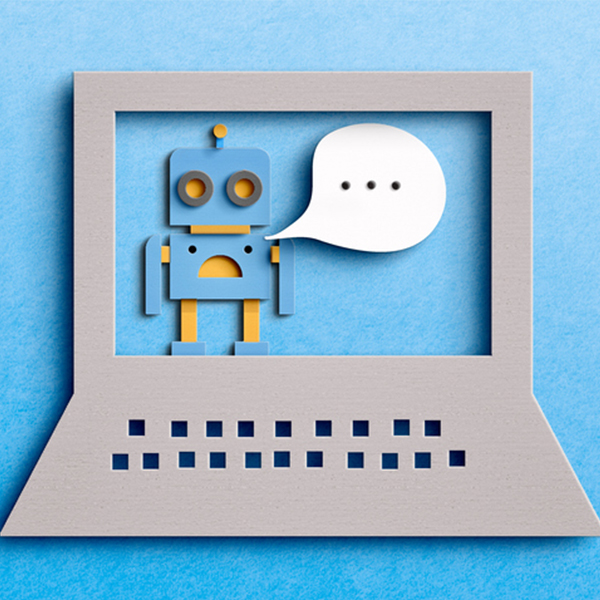
Paper cutout of chatbot on computer screen (Carol Yepes, Getty Images)

Paper cutout of chatbot on computer screen (Carol Yepes, Getty Images)
How does this align with my curriculum?
| Grade | Course | Topic |
|---|
Students will learn to explore how computers work by investigating how inputs get processed and appear as outputs.
Overview
| Activities | Timing | Student grouping | Description |
|---|---|---|---|
| Minds-On: Quick, Draw! | 20-30 minutes | Independent and Large group | Students will explore a machine learning online game and discuss this type of machine learning. |
| Action: How Machine Learning Works | 30-40 minutes | Small group and Large group | Students will learn about the types and processes of machine learning. |
| Consolidation: Applications of Machine Learning | 20-30 minutes | Independent and Large group | Students will explore connections between machine learning and the UN Sustainable Development Goals (SDGs) |
This lesson can be done over a few days.
Students will:
- Understand the basics of machine learning
- Participate in hands-on machine learning activities
- Apply Computational Thinking Practices
- Explore how machine learning could be used to address UN Sustainable Develop Goals (SDGs)
Learning Goals
Students will:
- Understand the basics of machine learning
- Participate in hands-on machine learning activities
- Apply Computational Thinking Practices
- Explore how machine learning could be used to address UN Sustainable Develop Goals (SDGs)
Students can:
- Describe the three main types of machine learning
- Use the computational thinking practices of algorithmic thinking and pattern recognition
- Identify examples of machine learning in everyday life
- Make connections between machine learning and SDGs
Success Criteria
Students can:
- Describe the three main types of machine learning
- Use the computational thinking practices of algorithmic thinking and pattern recognition
- Identify examples of machine learning in everyday life
- Make connections between machine learning and SDGs
This icon indicates potential assessment opportunities.
Observations
- Listen to students' responses about input and output after the Quick Draw activity.
- Listen and observe the discussion related to the types and uses of machine learning, making note of any areas for further discussion and exploration.
Conversations
- Have conversations with each small group about how they grouped the objects and the sorting rule, or algorithm, they generated.
Products
- Responses on the Machine Learning Concept Definition Web reproducible.
- Responses to questions generated during the Silent Discussion/Graffiti activity.
Evidence of Student Learning
This icon indicates potential assessment opportunities.
Observations
- Listen to students' responses about input and output after the Quick Draw activity.
- Listen and observe the discussion related to the types and uses of machine learning, making note of any areas for further discussion and exploration.
Conversations
- Have conversations with each small group about how they grouped the objects and the sorting rule, or algorithm, they generated.
Products
- Responses on the Machine Learning Concept Definition Web reproducible.
- Responses to questions generated during the Silent Discussion/Graffiti activity.
Students will:
- Understand the basics of machine learning
- Participate in hands-on machine learning activities
- Apply Computational Thinking Practices
- Explore how machine learning could be used to address UN Sustainable Develop Goals (SDGs)
Learning Goals
Students will:
- Understand the basics of machine learning
- Participate in hands-on machine learning activities
- Apply Computational Thinking Practices
- Explore how machine learning could be used to address UN Sustainable Develop Goals (SDGs)
Students can:
- Describe the three main types of machine learning
- Use the computational thinking practices of algorithmic thinking and pattern recognition
- Identify examples of machine learning in everyday life
- Make connections between machine learning and SDGs
Success Criteria
Students can:
- Describe the three main types of machine learning
- Use the computational thinking practices of algorithmic thinking and pattern recognition
- Identify examples of machine learning in everyday life
- Make connections between machine learning and SDGs
This icon indicates potential assessment opportunities.
Observations
- Listen to students' responses about input and output after the Quick Draw activity.
- Listen and observe the discussion related to the types and uses of machine learning, making note of any areas for further discussion and exploration.
Conversations
- Have conversations with each small group about how they grouped the objects and the sorting rule, or algorithm, they generated.
Products
- Responses on the Machine Learning Concept Definition Web reproducible.
- Responses to questions generated during the Silent Discussion/Graffiti activity.
Evidence of Student Learning
This icon indicates potential assessment opportunities.
Observations
- Listen to students' responses about input and output after the Quick Draw activity.
- Listen and observe the discussion related to the types and uses of machine learning, making note of any areas for further discussion and exploration.
Conversations
- Have conversations with each small group about how they grouped the objects and the sorting rule, or algorithm, they generated.
Products
- Responses on the Machine Learning Concept Definition Web reproducible.
- Responses to questions generated during the Silent Discussion/Graffiti activity.
Materials and Preparation
| Material/Technology/Setting | Quantity |
|---|---|
|
1 per student |
|
1 per group of 3 students |
|
For teacher use |
Materials
| Material/Technology/Setting | Quantity |
|---|---|
|
1 per student |
|
1 per group of 3 students |
|
For teacher use |
- Before beginning the lesson, familiarize yourself with the resources and videos that the students will use.
- Write the questions for the Silent Discussion/Graffiti activity on the pieces of chart paper.
Preparation
- Before beginning the lesson, familiarize yourself with the resources and videos that the students will use.
- Write the questions for the Silent Discussion/Graffiti activity on the pieces of chart paper.
- Some familiarity with Artificial Intelligence (AI) is an asset.
Student Prior Knowledge and Skills
- Some familiarity with Artificial Intelligence (AI) is an asset.
| Material/Technology/Setting | Quantity |
|---|---|
|
1 per student |
|
1 per group of 3 students |
|
For teacher use |
Materials
| Material/Technology/Setting | Quantity |
|---|---|
|
1 per student |
|
1 per group of 3 students |
|
For teacher use |
- Before beginning the lesson, familiarize yourself with the resources and videos that the students will use.
- Write the questions for the Silent Discussion/Graffiti activity on the pieces of chart paper.
Preparation
- Before beginning the lesson, familiarize yourself with the resources and videos that the students will use.
- Write the questions for the Silent Discussion/Graffiti activity on the pieces of chart paper.
- Some familiarity with Artificial Intelligence (AI) is an asset.
Student Prior Knowledge and Skills
- Some familiarity with Artificial Intelligence (AI) is an asset.
Teaching and Learning Activities
This icon indicates potential assessment opportunities.
Minds-On: Quick Draw [20-30 min.]
| Instructions | Teaching Tips |
|---|---|
|
Explain to students that they are going to be exploring a subset of Artificial Intelligence (AI) called machine learning. To see an example of machine learning in action, have students navigate to the online activity called Quick, Draw. 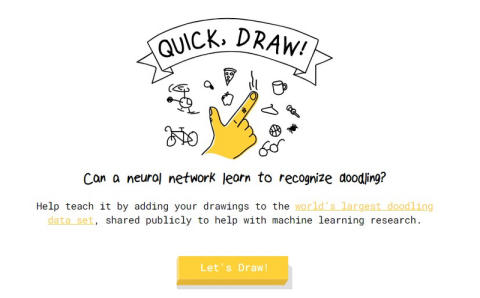
When they click the “Let’s Draw!” button, they will be asked to draw an object. As they draw, the program will try to predict what they are drawing. There are six simple drawings for them to complete. If they wish, they can click on an image to understand how the program determined what they were drawing and to see examples submitted by other people. |
TechnologyQuick Draw is an online game developed by Google. It uses a form of machine learning called neural networks and data from over 50 million drawings to guess what users are drawing in real time. Students with motor skill challenges could be partnered up with a buddy to play the game. Students who are blind or have low vision could do a similar activity by acting out a word and having other students guess the word. |
|
Afterwards, have students watch the video explanation of the game A.I. Experiments: Quick, Draw! They can access it themselves by clicking on the pink question mark button at the upper left side of the main Quick, Draw page. Have students share their thoughts about the activity using discussion prompts such as the ones on the right. After the discussion, help students to understand that what the computer game was doing was making predictions. The student gave the computer program an input (their drawing) and the computer tried to predict what they were drawing. The prediction was given in the form of a word, which was the output. |
DiscussionsDiscussion prompts can include:
|
|
Lead a class discussion about examples of when AI is used to make predictions. Student examples may include voice assistants, real-time driving directions, translation programs, shopping recommendations, video viewing recommendations and auto correct features. |
Community ConnectionsStudents could be challenged to think about all the local businesses that utilize technology to make predictions. For example, how could predictions be used to make things better in a community? |
Action: How Machine Learning Works [30-40 min.]
| Instructions | Teaching Tips |
|---|---|
|
Have students read the Let’s Talk Science Backgrounder What is Machine Learning? Alternatively, have students watch the video Supervised vs Unsupervised vs Reinforcement Learning (6:26 min.). Divide students into groups of three and have each member of the group complete one of the pages (supervised, unsupervised, self-supervised) of the Machine Learning Concept Definition Web reproducible [Google doc] [Word doc] [PDF]. 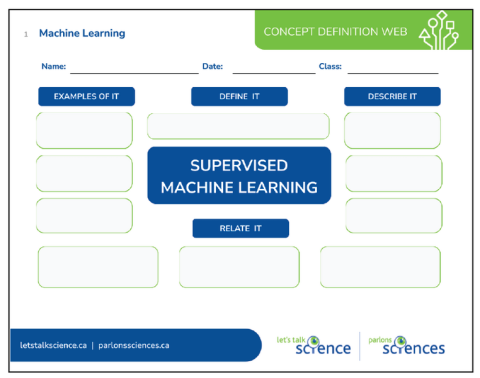
|
Language To assist students in understanding the text they could use a learning strategy such as Marking Text or work together in pairs. |
|
Have a class discussion about the three types of machines learning using discussion prompts such as the ones on the right. |
DiscussionsDiscussion prompts can include:
|
|
Explain to students that they will be doing an unsupervised machine learning activity. In this activity they will focus on a common unsupervised machine learning task called clustering. Provide each group of students with an assortment of objects, such as:
The objects represent a set of data. Instruct the students to sort the objects into groups of their choice. There are no right or wrong ways to sort the objects. 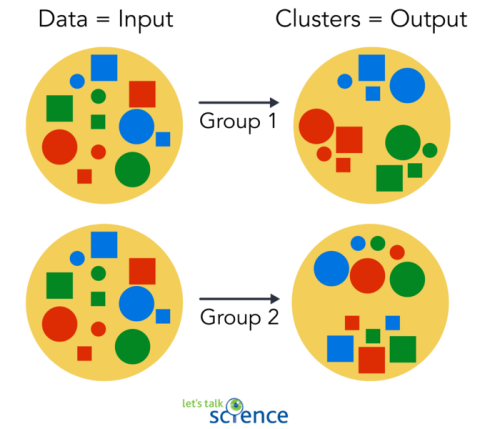
|
IdeaIf you wish you could have students use a Sorting Mats learning strategy. |
|
Afterwards, based on how the students sorted their objects, have them identify sorting rules or algorithms that could be used to put new objects into the correct groupings. For example, group 1 above sorted their shapes by colour. They could then set up a sorting rule that when a new shape was presented, the rule would put the shape into a cluster according to its colour. |
TechnologyStudents could use the block coding program Scratch to test and show their algorithm to others. IdeaStudents could get other groups to sort the objects using only their algorithm. |
|
Lead a class discussion about examples of when machine learning is used in clustering. Clustering is used in fraud detection, marketing campaigns, user personas, medical imaging and more. For example:
|
DiscussionsDiscussion prompts can include:
IdeaStudents could look for other examples of clustering used in everyday life. |
Consolidation: Applications of Machine Learning [20-30 min.]
| Instructions | Teaching Tips |
|---|---|
|
Students will consolidate and extend their knowledge using a Silent Discussion/Graffiti learning strategy. As part of this activity, students will walk around the room and answer questions related to how machine learning can be used to help solve real world problems. 
How could machine learning be used to reduce hunger? (SDG2) 
How could machine learning be used to improve human health? (SDG3) 
How could machine learning be used to improve education? (SDG4) 
How could machine learning be used to provide the world with clean energy? (SDG7) Afterwards, read out and discuss the responses on the sheets. |
IdeaPost the papers around the room in locations that will be accessible to all students. IdeaFour question prompts are provided, but you may wish to choose others depending on your unit of study. |
| This activity could be followed up by having students complete a personal reflection about machine learning and AI using a learning strategy such as Used to Think, Now I Think. |
Background Information for Teachers
Artificial Intelligence and SDGs
Artificial intelligence and machine learning has the potential to greatly improve our ability to meet SDGs.
For example, it can help support the development of low-carbon systems by supporting circular economies and smart cities that efficiently use their resources.
It can also help people to analyze large-scale interconnected databases so that they can develop actions aimed at preserving the environment.
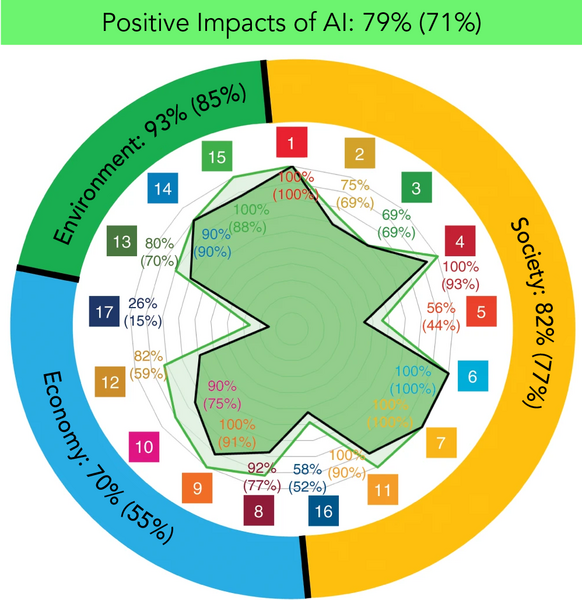
However, AI can be a detriment for meeting some aspects of SDGs.
For example, advanced AI requires massive computational resources only available in large computing centers. These facilities have a very high energy requirement and carbon footprint.
Another important drawback is that the solutions AI generates are based on the needs and values of nations in which it is being developed. This can potentially lead to problems such as biased election results and an increase in hate-related crimes.
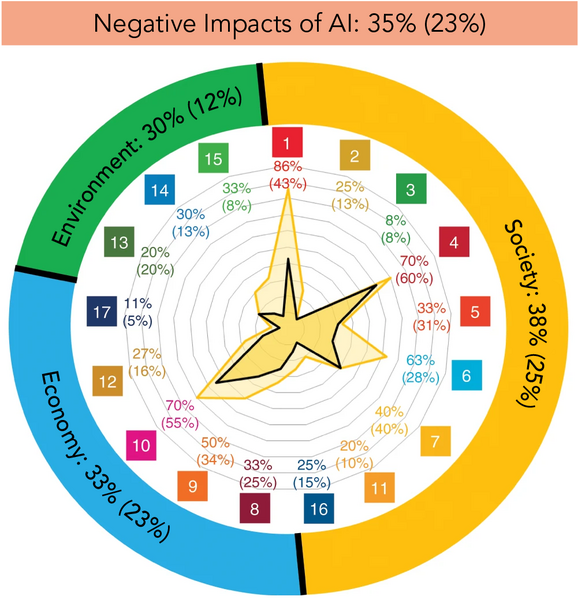
Additional Resources
Reproducibles
- Machine Learning Concept Definition Web reproducible [Google doc] [Word doc] [PDF]
Videos
Reproducibles and Media
Reproducibles
- Machine Learning Concept Definition Web reproducible [Google doc] [Word doc] [PDF]
Videos
Literacy
- This blog post has ideas for ways to use the Quick Draw game in literacy activities.
Mathematical Thinking
- Have students try clustering the objects in as many different ways as possible.
- Add new objects to the group used in the clustering activity and have students determine if their algorithm needs to be changed.
Computational Thinking
- Scratch Lab now has face-sensing blocks that run using machine learning. Students can click on the globe icon at the top of the page to access other languages.
- The Teachable Machine from Google lets students train a computer to recognize their own images, sounds, & poses. Students can click on the globe icon at the bottom right of the page to access other languages.
Career Education
- Have guest speakers who work in the field of machine learning share their experiences and insights exposing students to possible future careers.
Extensions
Literacy
- This blog post has ideas for ways to use the Quick Draw game in literacy activities.
Mathematical Thinking
- Have students try clustering the objects in as many different ways as possible.
- Add new objects to the group used in the clustering activity and have students determine if their algorithm needs to be changed.
Computational Thinking
- Scratch Lab now has face-sensing blocks that run using machine learning. Students can click on the globe icon at the top of the page to access other languages.
- The Teachable Machine from Google lets students train a computer to recognize their own images, sounds, & poses. Students can click on the globe icon at the bottom right of the page to access other languages.
Career Education
- Have guest speakers who work in the field of machine learning share their experiences and insights exposing students to possible future careers.
A Case Study of Autonomous Trucks
In this Let’s Talk Science resource, students learn how artificial intelligence is affecting the trucking industry as a way to explore how technology and society are related.
How AIs, like ChatGPT, Learn (2018)
In this video (8:54 min.), students learn how AI technologies, such as ChatGPT, learn.
Teach a computer to play a game
This free tool from Machine Learning for Kids introduces machine learning by providing hands-on experiences for training machine learning systems and building things with them.
Learn More
A Case Study of Autonomous Trucks
In this Let’s Talk Science resource, students learn how artificial intelligence is affecting the trucking industry as a way to explore how technology and society are related.
How AIs, like ChatGPT, Learn (2018)
In this video (8:54 min.), students learn how AI technologies, such as ChatGPT, learn.
Teach a computer to play a game
This free tool from Machine Learning for Kids introduces machine learning by providing hands-on experiences for training machine learning systems and building things with them.
Altexsoft. (2021, April 14). Unsupervised Learning: Algorithms and Examples.
Simonetta, R. (2023, May 29). Machine learning is leading the way in tracking financial tricksters. Chartered Professional Accountants Canada.
Vinuesa, R., Azizpour, H., Leite, I. et al. The role of artificial intelligence in achieving the Sustainable Development Goals. Nat Commun 11, 233 (2020). https://doi.org/10.1038/s41467-019-14108-y)
References
Altexsoft. (2021, April 14). Unsupervised Learning: Algorithms and Examples.
Simonetta, R. (2023, May 29). Machine learning is leading the way in tracking financial tricksters. Chartered Professional Accountants Canada.
Vinuesa, R., Azizpour, H., Leite, I. et al. The role of artificial intelligence in achieving the Sustainable Development Goals. Nat Commun 11, 233 (2020). https://doi.org/10.1038/s41467-019-14108-y)
Reproducibles
- Machine Learning Concept Definition Web reproducible [Google doc] [Word doc] [PDF]
Videos
Reproducibles and Media
Reproducibles
- Machine Learning Concept Definition Web reproducible [Google doc] [Word doc] [PDF]
Videos
Literacy
- This blog post has ideas for ways to use the Quick Draw game in literacy activities.
Mathematical Thinking
- Have students try clustering the objects in as many different ways as possible.
- Add new objects to the group used in the clustering activity and have students determine if their algorithm needs to be changed.
Computational Thinking
- Scratch Lab now has face-sensing blocks that run using machine learning. Students can click on the globe icon at the top of the page to access other languages.
- The Teachable Machine from Google lets students train a computer to recognize their own images, sounds, & poses. Students can click on the globe icon at the bottom right of the page to access other languages.
Career Education
- Have guest speakers who work in the field of machine learning share their experiences and insights exposing students to possible future careers.
Extensions
Literacy
- This blog post has ideas for ways to use the Quick Draw game in literacy activities.
Mathematical Thinking
- Have students try clustering the objects in as many different ways as possible.
- Add new objects to the group used in the clustering activity and have students determine if their algorithm needs to be changed.
Computational Thinking
- Scratch Lab now has face-sensing blocks that run using machine learning. Students can click on the globe icon at the top of the page to access other languages.
- The Teachable Machine from Google lets students train a computer to recognize their own images, sounds, & poses. Students can click on the globe icon at the bottom right of the page to access other languages.
Career Education
- Have guest speakers who work in the field of machine learning share their experiences and insights exposing students to possible future careers.
A Case Study of Autonomous Trucks
In this Let’s Talk Science resource, students learn how artificial intelligence is affecting the trucking industry as a way to explore how technology and society are related.
How AIs, like ChatGPT, Learn (2018)
In this video (8:54 min.), students learn how AI technologies, such as ChatGPT, learn.
Teach a computer to play a game
This free tool from Machine Learning for Kids introduces machine learning by providing hands-on experiences for training machine learning systems and building things with them.
Learn More
A Case Study of Autonomous Trucks
In this Let’s Talk Science resource, students learn how artificial intelligence is affecting the trucking industry as a way to explore how technology and society are related.
How AIs, like ChatGPT, Learn (2018)
In this video (8:54 min.), students learn how AI technologies, such as ChatGPT, learn.
Teach a computer to play a game
This free tool from Machine Learning for Kids introduces machine learning by providing hands-on experiences for training machine learning systems and building things with them.
Altexsoft. (2021, April 14). Unsupervised Learning: Algorithms and Examples.
Simonetta, R. (2023, May 29). Machine learning is leading the way in tracking financial tricksters. Chartered Professional Accountants Canada.
Vinuesa, R., Azizpour, H., Leite, I. et al. The role of artificial intelligence in achieving the Sustainable Development Goals. Nat Commun 11, 233 (2020). https://doi.org/10.1038/s41467-019-14108-y)
References
Altexsoft. (2021, April 14). Unsupervised Learning: Algorithms and Examples.
Simonetta, R. (2023, May 29). Machine learning is leading the way in tracking financial tricksters. Chartered Professional Accountants Canada.
Vinuesa, R., Azizpour, H., Leite, I. et al. The role of artificial intelligence in achieving the Sustainable Development Goals. Nat Commun 11, 233 (2020). https://doi.org/10.1038/s41467-019-14108-y)